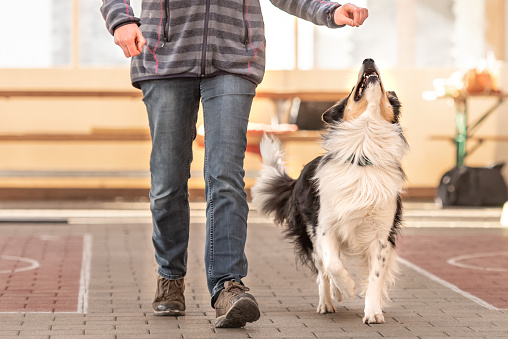- What Are Cardiac Service Dogs?
- Who Can Benefit from Cardiac Service Dogs?
- How Do Cardiac Alert Dogs Detect Changes in the Heart Rate or the Blood Flow?
- How Can a Dog be Trained to Become a Cardiac Service Dog?
- Tasks That Cardiac Service Dogs Can Be Trained to Perform
- How Long Can Cardiac Service Dog Training Last?
- What Are the Costs for a Medical Service Dog?

Cardiac service dogs are a specialized type of service animal trained to assist individuals with heart conditions. These dogs can detect changes in their handler's heart rate and blood pressure, alert them to potential cardiac events, and provide support in emergencies. In this comprehensive guide, we will explore the world of cardiac service dogs, including their training, tasks, benefits, and how they can significantly improve the quality of life for those with heart conditions.
What Are Cardiac Service Dogs?
Cardiac service dogs are trained to assist individuals with various heart conditions, such as arrhythmias, heart failure, and other cardiovascular diseases. These dogs are equipped to recognize the early signs of a cardiac event, such as a change in heart rate or the blood pressure of their handler, and alert their handlers to take preventive measures.
The Role of Cardiac Service Dogs
The primary role of a cardiac service dog is to monitor their handler's physical state and provide alerts to changes that may indicate a heart problem. These dogs can perform a variety of tasks, including:
• Alerting to Heart Rate Changes: Sensing changes in the handler's heart rate and alerting them to take medication or seek medical help.
• Fetching Medication: Retrieving medications or medical devices in case of an emergency.
• Providing Physical Support: Offering balance and stability to handlers who may feel dizzy or weak due to their heart condition.
• Seeking Help: Finding another person or activating an emergency alert system if the handler is incapacitated.
• Comforting and Reducing Stress: Providing emotional support and companionship, which can help reduce stress and anxiety, contributing to overall heart health.
Cardiac Response Dogs are trained to respond to the handler’s needs after the event has occurred. The tasks that cardiac response dogs can perform are different. Some of them include: retrieving medication, calling 911, laying down along with their handler and comforting them, opening doors...etc. The tasks may vary, and we will take a closer look at them later in the article.
Who Can Benefit from Cardiac Service Dogs?
There are many people, who are dealing with different types of heart conditions and can benefit from the presence of a Cardiac Service Dog. Cardiac service dogs can assist individuals with a wide range of heart conditions, including:
• Arrhythmias: Irregular heartbeats that can lead to severe complications if not managed promptly.
• Heart Failure: A condition where the heart cannot pump enough blood to meet the body's needs.
• Coronary Artery Disease: A disease caused by the buildup of plaque in the coronary arteries, which can lead to chest pain or heart attacks.
• Postural Orthostatic Tachycardia Syndrome (POTS): A condition that affects blood flow and can cause dizziness and fainting.
• Congenital Heart Defects: Heart abnormalities present at birth that require ongoing management.
One of the most significant benefits of cardiac service dogs is their ability to detect early signs of a cardiac event. By alerting their handler to changes in heart rate or blood pressure, these dogs can prevent severe complications and ensure timely medical intervention. Cardiac service dogs provide their handlers with a greater sense of independence. Individuals with heart conditions often feel anxious about their health and may rely heavily on caregivers. With a cardiac service dog, they can feel more confident in managing their condition and participating in daily activities. The companionship of a cardiac service dog can significantly reduce stress and anxiety, which are known to impact heart health negatively. These dogs offer unconditional love and support, which can improve their handler's overall well-being. By assisting with daily tasks and providing constant support, cardiac service dogs can enhance the quality of life for individuals with heart conditions. Handlers can engage more fully in social activities, exercise, and other aspects of life that contribute to overall happiness and health.
How Do Cardiac Alert Dogs Detect Changes in the Heart Rate or the Blood Flow?
Cardiac dogs are likely to use their strong sense of smell to recognize chemical alterations that occur when the blood pressure or the heart rate changes. They may be able to use their strong hearing skills to recognize whether the heart rate is normal or not.
Some of you may wonder how these dogs can be trained to become cardiac alert service dogs.
How Can a Dog be Trained to Become a Cardiac Service Dog?
You need to remember, that not every dog is suitable for work as a service dog, especially as a medical alert dog. Service dogs must possess certain behavioral features like being trainable, intelligent, easy-going, being around people, having a strong bond with their handlers, and having a calm and stable personality. Furthermore, some tasks require even more specific features like physical strength and robust bone structure. Strong obedience skills and showing good manners while in public is mandatory for every service dog. When it comes to cardiac or any type of alert service animals, they would be more effective in their work if their breed is long-nosed.
Once you find a dog considered appropriate as a cardiac alert animal, you need to know how to train him/her.
The so-called swab technique can be used for cardiac service dog training. If you would like to apply this approach you will need two swabs. One of them should be soaked in the individual’s saliva when the heart rate and blood pressure are within the normal range. The other one should be soaked in the person’s saliva when changes in the heart rate, the blood flow or any cardiac symptoms occur. After your dog smells both swabs you need to train him/her to notify you about the oncoming event through a signal like barking, pawing, nudging...etc. The process requires a lot of practice and positive reinforcement when your paw friend performs the task correctly.
Please note that a dog should already possess the innate ability to sense heart rate or blood pressure changes. This ability can be enhanced, and the dog can be trained to respond properly, but you can not expect any dog to be able to become a cardiac service dog.
Tasks That Cardiac Service Dogs Can Be Trained to Perform
These dogs can be trained in different tasks, depending on the person’s symptoms and needs.
Cardiac Service Dogs can call 911 in both cases- when they recognize that their handler/user is about to experience a cardiac symptom, and after they already experienced it.
These canines can retrieve medication, pick up objects, dropped due to dizziness or blackout, protect the body of their handler from injuries caused by falling on the ground using their own body, and open and close doors or drawers. They can also be trained to assist with shopping or other daily activities, that the handler is unable to do themselves due to their condition. The tasks that a cardiac service dog, and basically any medical service dog, can be trained to perform, may vary. Handlers can adjust the training process to their daily needs.
However, handlers should take the dog’s health, physique, and natural abilities into consideration before starting to train him/her as a service dog.
How Long Can Cardiac Service Dog Training Last?
International recognized organizations like IGDF and ADI set high standards in regard to the service dog training process and require a minimum of 120 training hours. 30 hours of them must be spent in public. Based on the dog’s personality, temperament, and intelligence as well as the tasks’ level of difficulty, the training process may take up to one to two years or even more until the dog is fully trained as a cardiac service dog.
ADA (Americans with Disabilities Act) states that handlers are permitted to train their own dogs as service dogs. If you consider this option acceptable, you will need to invest a lot of time, effort, patience, and consistency.
Another option to get a cardiac service dog is to contact a training organization near you.
Some organizations engaged in cardiac service dog training across the US are:
-
Canine Partners for Life;
-
Perfect Fit Canines.
For self-train owner, here is great news! SDTSI's Cardiac Service Dog Training Course is dedicated to equipping those who wish to train their own dogs as cardiac service dogs. The course is split into four segments, each focusing on separate topics related to the basics of training and handling a service dog. Students have access to lectures, reading material, and videos that demonstrate methods for teaching tasks and behaviors specific to cardiac service dogs.
What Are the Costs for a Medical Service Dog?
You may need to pay up to $30,000 if you want to get a trained medical alert dog. Some organizations offer fundraising as an option. However, in this case, you are likely to wait for a while until you fundraise all the money needed. If you decide to reach out to a non-profit organization, you need to be ready to wait for one to two years before you receive a service dog, as the waiting lists are usually long.
If you are a US citizen, you can train your own service dog (according to ADA), however, you have to be fully committed to the process of raising, training, and taking care of the service dog. You need to secure the dog's regular veterinarian visits, healthy food, practice, and quality rest time.
What Breeds Are Deemed Most Suitable as Cardiac Service Dogs?
Since we are looking for friendly, disciplined, trainable, intelligent breeds, with large noses if possible, there is no surprise that these breeds occupy the leading positions: the Retrievers (Golden Retriever and Labrador Retriever), the German Shepherd, the Poodle, the Grate Dane...etc. However, we would like to note that when it comes to a service animal, the temperament of the individual dog is of utmost importance.
Medical Alert Dogs and Service Dogs in general can perform various tasks both physical and emotional and be a vital part of the lives of many people, who are dealing with daily challenges due to a disability.
Cardiac service dogs play a crucial role in supporting individuals with heart conditions. Through their specialized training and tasks, these dogs provide early detection, increased independence, emotional support, and enhanced safety. The journey to obtaining a cardiac service dog involves careful assessment, choosing a reputable organization, and committing to the ongoing care and training of the dog.
As awareness of cardiac service dogs continues to grow, more individuals with heart conditions can benefit from their remarkable support. By understanding the role and benefits of cardiac service dogs, we can appreciate the profound impact these animals have on the lives of those they assist. If you or someone you know could benefit from a cardiac service dog, consider exploring this option as a valuable addition to your heart health management plan.















